

Extinction event wiped out a THIRD of marine animals. More than 2 million years ago, a third of the Earth's largest marine animals including giant sharks, whales and sea turtles disappeared, according to a new study.

Researchers discovered that this previously unknown extinction event had a huge impact on the Earth's biodiversity. The team hopes its findings will help to prevent a present-day parallel from occurring. Scroll down for video Over two million years ago, a third of the Earth's largest marine animals including sharks, whales and sea turtles, disappeared, according to a new study.
Extinction events. The blue graph shows the apparent percentage (not the absolute number) of marine animalgenera becoming extinct during any given time interval.
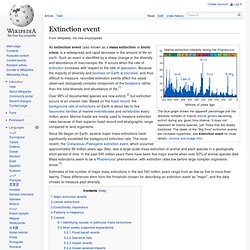
It does not represent all marine species, just those that are readily fossilized. The labels of the "Big Five" extinction events are clickable hyperlinks; see Extinction event for more details. (source and image info) Since life began on Earth, several major mass extinctions have significantly exceeded the background extinction rate. 450-440mya: Ordovician–Silurian extinction event. Millions of years ago The blue graph shows the apparent percentage (not the absolute number) of marine animalgenera becoming extinct during any given time interval.

It does not represent all marine species, just those that are readily fossilized. End-Ordovician mass extinction. When did it happen?

Fossil of a 'tuning fork' graptolite, Didymograptus. Some of these colonial marine animals were victims of the end-Ordovician mass extinction. Around 445-440 million years ago, possibly in 2 phases. What went extinct? 26% of all marine families, 60% of all genera, an estimated 82-88% of all species. Although no major groups were completely lost, many sea creatures suffered substantial losses. Causes As large ice sheets formed in the Late Ordovician, sea levels fell dramatically, draining inland seas. 374mya: Late Devonian extinction. Millions of years ago Late D Comparison of the three episodes of extinction in the Late Devonian ("Late D") to other mass extinction events in Earth's history.
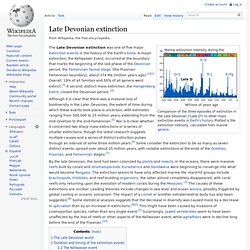
Plotted is the extinction intensity, calculated from marine genera. Although it is clear that there was a massive loss of biodiversity in the Later Devonian, the extent of time during which these events took place is uncertain, with estimates ranging from 500,000 to 25 million years, extending from the mid-Givetian to the end-Famennian.[5] Nor is it clear whether it concerned two sharp mass extinctions or a series of smaller extinctions, though the latest research suggests multiple causes and a series of distinct extinction pulses through an interval of some three million years.[6] Some consider the extinction to be as many as seven distinct events, spread over about 25 million years, with notable extinctions at the ends of the Givetian, Frasnian, and Famennian stages.[7]
Late Devonian mass extinction. Following the end-Ordovician mass extinction, the diversity of many of the affected marine invertebrate groups increased again.

Fish became a prominent part of marine and freshwater fauna. 260mya: Emeishan Traps (China) The Emeishan Traps constitute a flood basalt volcanic province, or large igneous province, in southwestern China, centered in Sichuan province.
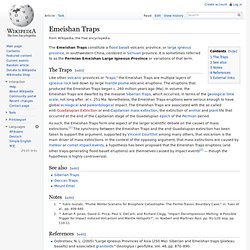
It is sometimes referred to as the Permian Emeishan Large Igneous Province or variations of that term. The Traps[edit] As such, the Emeishan Traps form one aspect of the larger scientific debate on the causes of mass extinctions.[1] The synchrony between the Emeishan Traps and the end-Guadalupian extinction has been taken to support the argument, supported by Vincent Courtillot among many others, that volcanism is the main driver of mass extinctions. In the context of the opposing argument, that mass extinctions are caused by meteor or comet impact events, a hypothesis has been proposed that the Emeishan Traps eruptions (and other traps-generating flood basalt eruptions) are themselves caused by impact events[2] — though the hypothesis is highly controversial.
See also[edit] Notes[edit] References[edit] Dobretsov, N. External links[edit] 252mya: Permian–Triassic extinction event. Millions of years ago P–Tr. End-Permian mass extinction (the Great Dying) Following the Late Devonian extinction, sharks filled the ecological gap left by the disappearance of the heavily armoured fish, placoderms.
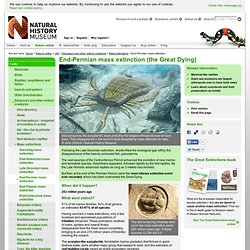
The vast swamps of the Carboniferous Period enhanced the evolution of new marine and terrestrial species. Amphibans appeared, followed rapidly by the first reptiles. By the Late Permian advanced reptiles as long as 3 metres had evolved. But then at the end of the Permian Period came the most intense extinction event ever recorded, which has been nicknamed the Great Dying.
The last remaining trilobites died out in the mass extinction event 252 million years ago. © Ryan Somma, CC BY-SA 2.0 When did it happen? 252 million years ago. What went extinct? 251mya: Siberian Traps (Russia) The extent of the Siberian Traps.
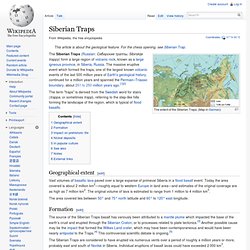
(Map in German) The Siberian Traps (Russian: Сибирские траппы, Sibirskije trappy) form a large region of volcanic rock, known as a large igneous province, in Siberia, Russia. 201.3mya: Triassic–Jurassic extinction event. Millions of years ago Tr–J The blue graph shows the apparent percentage (not the absolute number) of marine animalgenera becoming extinct during any given time interval.
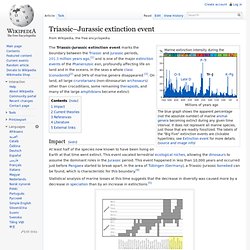
It does not represent all marine species, just those that are readily fossilized. End-Triassic mass extinction. After the cataclysmic Late Permian mass extinction, it took 10-20 million years for life to recover its previous diversity. But it did recover, and in significant new ways. This was particularly true of vertebrates. Mammal-like reptiles flourished. Walrus-like reptiles, placodonts, appeared in the shallow seas. Sharks and fish diversified. Anoxic event. Red circles show the location and size of many dead zones. Black dots show Ocean dead zones of unknown size.The size and number of marine dead zones—areas where the deep water is so low in dissolved oxygen that sea creatures can't survive—have grown explosively in the past half-century. – NASA Earth Observatory[1] This world perspective on oceanic currents demonstrates the interdependencies of transnational regions on circulating currents.
66mya: Cretaceous–Paleogene extinction event. Artist's rendering of a bolide impact A Wyoming (U.S.) rock with an intermediate claystone layer that contains 1000 times more iridium than the upper and lower layers. Picture taken at the San Diego Natural History Museum Complex Cretaceous–Paleogene clay layer (gray) in the Geulhemmergroeve tunnels near Geulhem, The Netherlands.
End-Cretaceous mass extinction. After the end-Triassic extinction, with most large amphibians and mammal-like reptiles gone, there was an opening for a new dominant land animal. Dinosaurs soon filled this, becoming by far the most common animals in most land habitats. 66mya: Deccan Traps (India) 66mya: Chicxulub Meteor Crater. List of extinct plants. Lists of extinct species. IUCN Red List of extinct species. From Wikipedia, the free encyclopedia This category lists the species considered as Extinct species in the IUCN Red List. (IUCN Red List category) Pages in category "IUCN Red List extinct species"